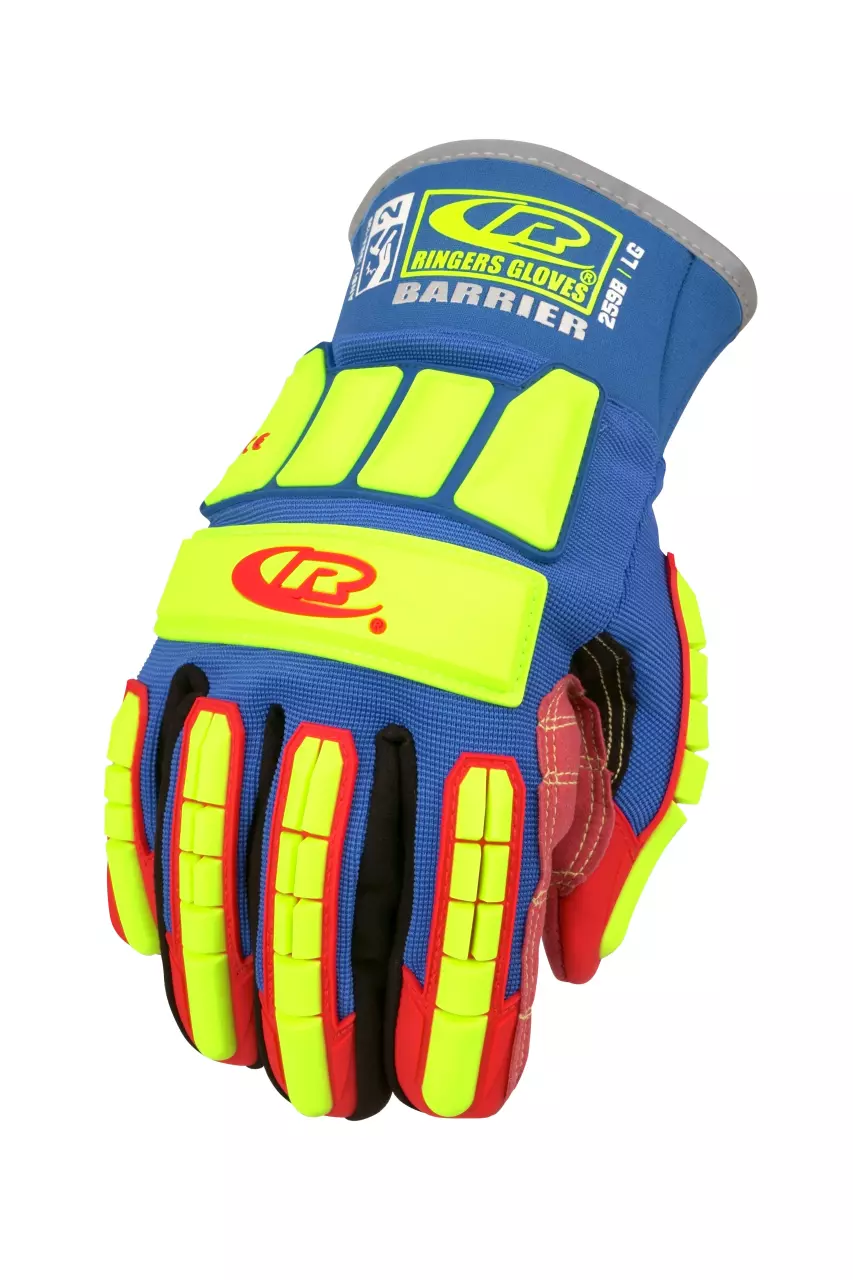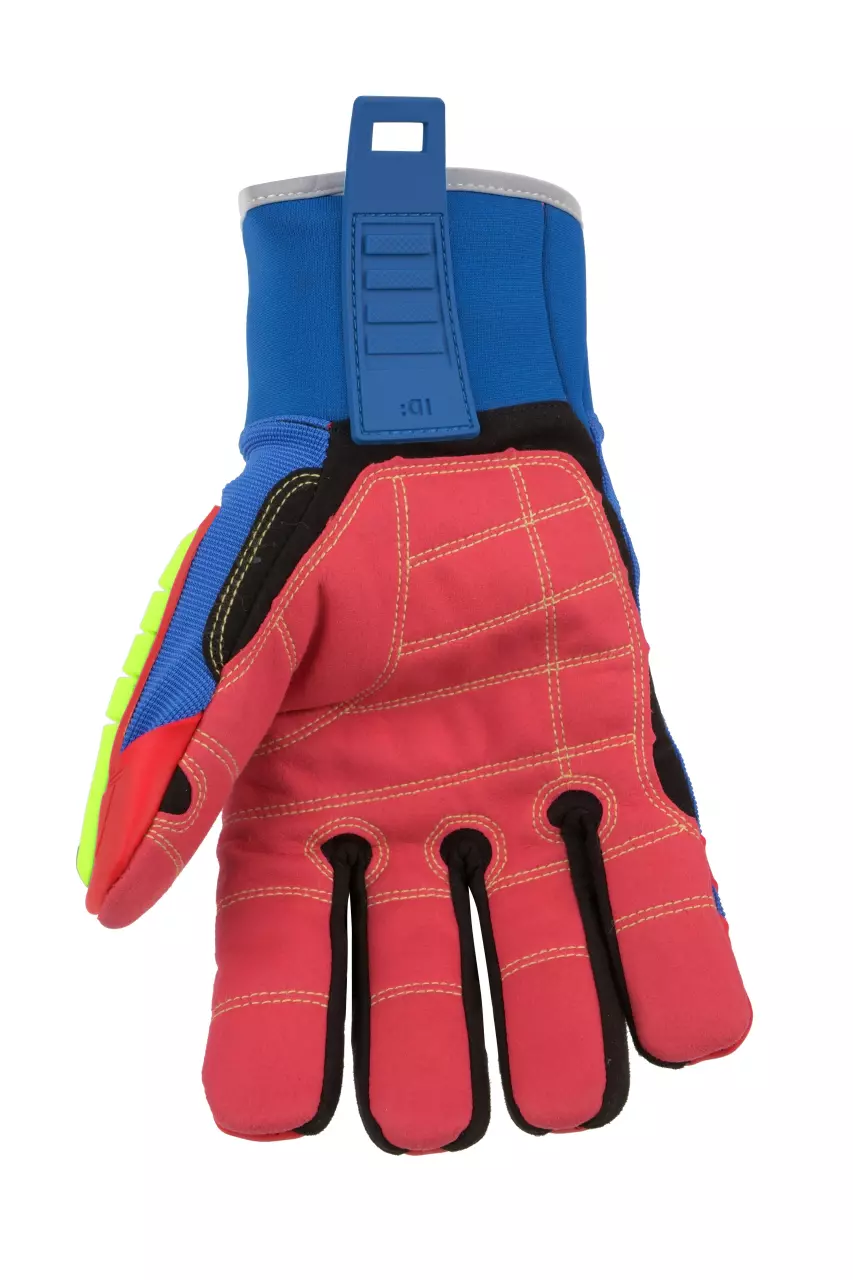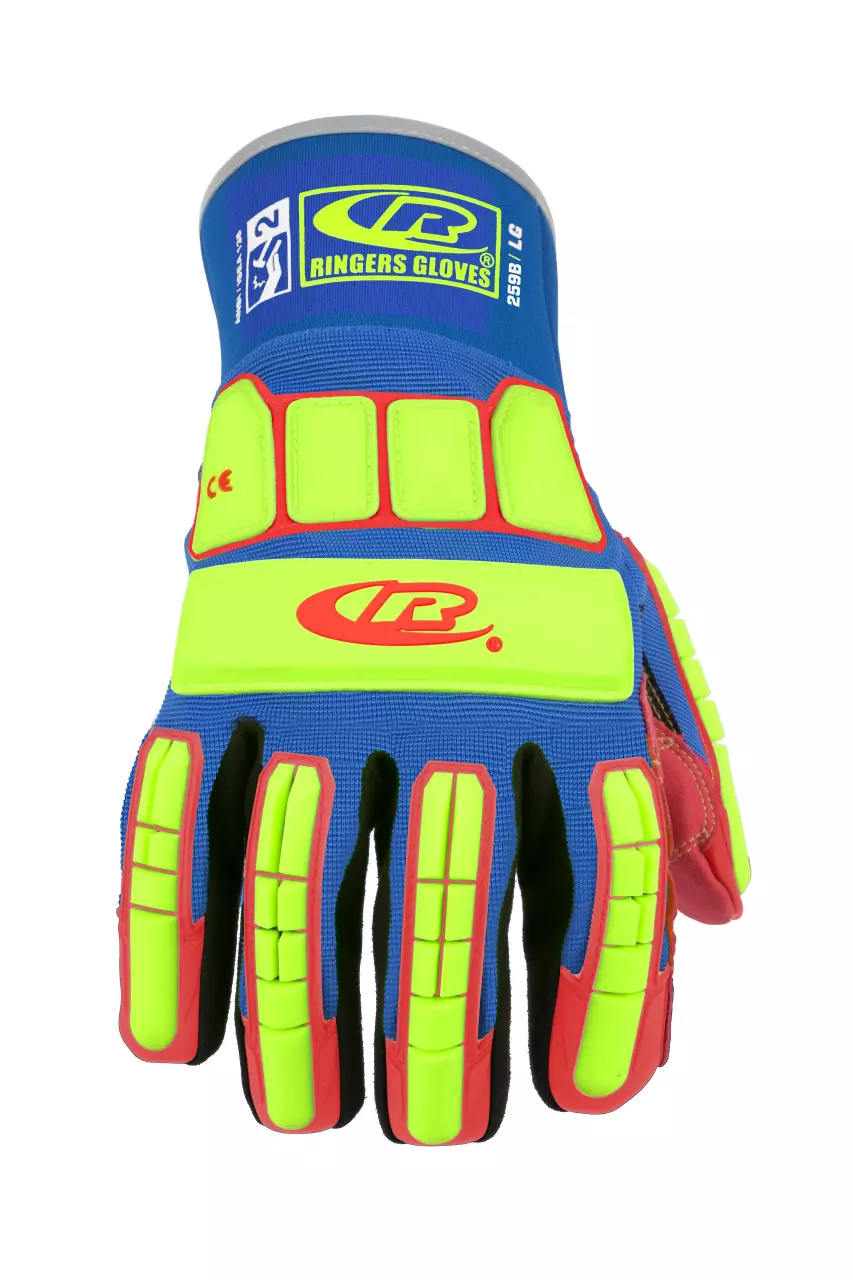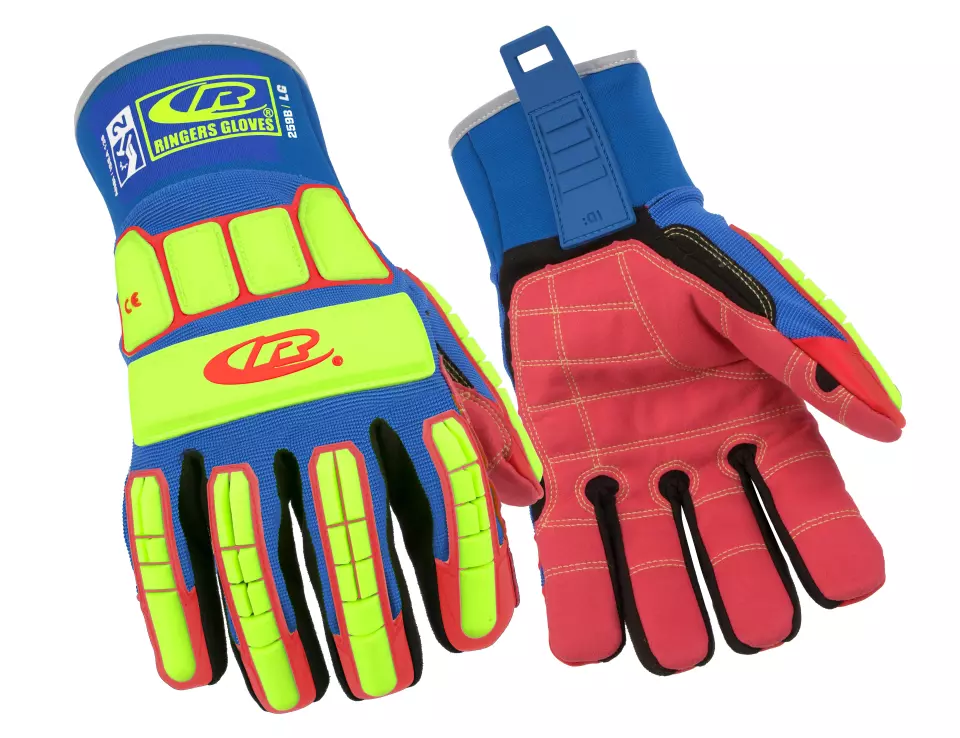Ansell Ringers 259B
Ansell
visit storeProduct description
Description
Specialized protection: RINGERS® R259B impact gloves’ patented TPR (thermoplastic rubber) design, developed with F3 Technology™, provides top-of-hand and finger-length protection
Advanced defenses: An additional palm layer enhances cut resistance, while a waterproof barrier and liquid-resistant coating at the top of the hand ensure dry, dependable personal protection
Optimized usability: Their advanced construction includes a durable bond between each layer, limiting glove separation when doffing
Strengthened grip: A synthetic leather palm ensures superb grip
Enhanced features: These RINGERS® gloves’ high-visibility design, with reflective cuff piping, further enhances safety levels, while an extended neoprene wrist closure ensures a secure fit
Recommended for
Engagement and release of drill string slips
Chaining up pipes
Facility and machinery maintenance
Installation and dismantling of rigs
Handling iron
Operating of heavy machinery
Equipment maintenance and repair
Pipe handling
Handling materials with sharp or rough edges
Loading and hauling
Hydraulic repair
Re-fuel oil fluid and diesel
Product Details
Available Sizes : 8, 9, 10, 11, 12, 13
Coating Color : Red
Construction : Cut & Sewn
Cuff Style : Extended Neoprene Wrist Closure
Grip Design : Synthetic Leather
Latex Free : Yes
Liner Material : Hppe
Washing Temperature : Handwash Cold Water
Suited for various tasks, these gloves offer essential protection and flexibility. A practical choice providing comfort and durability for everyday use.
Crafted from cut pieces of material sewn together, offering design flexibility and a tailored fit. Ideal for customized protection and comfort.
Provides complete hand coverage, shielding fingers from hazards. Offers maximum protection and warmth, ideal for demanding tasks and environments.
The design of the wrist area that secures the glove and prevents debris entry. Different styles offer varying levels of adjustability, protection, and comfort.
Identifies the material covering the glove's palm area, determining grip quality, protection level, dexterity, and durability for specific work environments.
The interior fabric that contacts your skin, affecting comfort, temperature regulation, moisture control, and allergen exposure during extended wear periods.
- Machine Washable
- Hand Protection
- Chemical Resistance
- Cold Protective
- Cut Resistant
- High Visibility
- Impact Resistance
- Water Resistance
Request a free sample
Test first and buy later. Visit any product page to request your free sample.
Standards and labels
EN 420:2003+A1:2009 is a European standard that sets out the general requirements for hand protection, including comfort, fit, and dexterity. Performance requirements include resistance to abrasion, cut, tear, puncture, and impact. Test results should show the gloves meet these requirements.
EN 388:2016 is a European standard for measuring the performance of protective gloves against mechanical risks (abrasion, cut, tear, and puncture). The standard includes test methods and performance requirements for gloves to be considered compliant. Test results are reported using a series of four numbers, each representing the performance level achieved in one of the tests.
Test results
Impact Protection P – PassedTear Resistance Level 4EN 388:2016 is a European standard that establishes criteria for assessing the protection provided by gloves against mechanical hazards, including tear resistance. The Tear Resistance Level 4 classification represents the highest level of tear resistance defined by this standard, indicating that the gloves can withstand the most substantial forces before tearing. According to the testing methodology, gloves are evaluated by measuring the force required to tear a sample of the glove material, with Level 4 requiring a force of over 75 Newtons to initiate and propagate a tear. This high level of tear resistance is ideal for use in environments where gloves are subjected to significant stress and potential damage, such as in heavy industry, construction, and handling of materials with sharp edges. Gloves achieving this level offer superior durability and are essential for ensuring user safety in high-risk mechanical settings, thereby enhancing work efficiency and reducing the frequency of glove replacement.
Puncture Resistance Level 4The standard EN 388:2016 includes a test for Puncture Resistance, where a Level 4 result indicates a protective performance that can withstand a force between 100 to 150 newtons. This specific level of puncture resistance reflects a significant protective capability, offering substantial protection against punctures from pointed objects like nails or wires. The test method includes using a standard stylus of a specific diameter, which is pressed against the sample material with increasing force until it punctures the material. A machine used for this test measures the force exerted at the moment the material is punctured. Practical implications of this result for products such as gloves or protective clothing mean that they are suitable for environments where there is a high risk of encountering medium to sharp objects that could pierce through lesser resistant materials, thus ensuring higher safety standards for workers in such conditions. This level of puncture resistance is particularly crucial in industries such as construction or waste management where sharp debris is common.
Cut Resistance, ISO 13997 Level XThe standard EN 388:2016, specifically its segment referring to ISO 13997 test, is designed to assess the cut resistance of materials used in protective gloves. A result denoted as 'Level X' means that test is not performed and the cut resistance of the product cannot be guaranteed.
Cut Resistance, ISO 13997 Level FThe EN ISO 13997 cut resistance test, stipulated in the standard EN 388:2016, includes Level F in its rating which represents a force greater than 30 Newtons before the material is penetrated by a blade. Level F indicates excellent performance in terms of resistance to cutting, protecting against extremely sharp objects. This test is conducted using a TDM machine where a single-use straight edge blade is drawn just once across the material in a linear direction until it cuts through. The force required to penetrate the material is then measured and recorded. In practical applications, Level F cut-resistant gloves are suitable for high-risk environments such as heavy metal stamping, waste management, and glass handling, where handling extremely sharp objects and materials is common. Gloves meeting this high standard of cut resistance ensure maximum protection and durability under severe conditions.
Abrasion Resistance Level 4EN 388:2016 uses a specific test method to measure abrasion resistance of safety gloves; the gloves’ material is subjected to sandpaper under pressure to observe the number of cycles needed to wear through the material. Level 4 in this standard indicates that the material withstood 8,000 cycles before a hole was made. Practically, this means that gloves rated at Level 4 for abrasion resistance offer very high resilience against wearing through, making them suitable for tasks involving significant contact with rough surfaces .
EN 511:2006 is a European standard that sets requirements for the protection against cold for gloves and mittens. It covers factors such as resistance to cold, water penetration and breathability. Testing must be done by a certified lab and must show that the product meets all requirements of the standard. Possible test results would include pass/fail for each requirement, as well as specific measurement data.
Test results
Cold Contact Level 2The standard EN 511:2006 specifies requirements for protective gloves that guard against cold environments. Cold Contact result Level 2 indicates moderate insulation against contact cold, quantified with a thermal resistance measurement in the range of 0.050 to less than 0.100 m²°C/W. This means gloves achieving this level can provide a reasonable amount of insulation, helping to reduce heat transfer from the hands to the cold contact surface, thereby lowering the rate at which hands become cold. The measurement of contact cold resistance is performed using a standardized test that involves placing the glove materials against metal plates cooled to different temperatures. The difference in temperature across the glove material is then analyzed to determine its thermal resistance. For practical implications, gloves classified under Level 2 of Cold Contact in EN 511:2006 are suitable for environments or tasks where individuals are exposed to cold objects but do not necessarily involve extreme cold or extended exposure, offering a balance between dexterity and protection from the cold .
Convective Cold Level 0EN 511:2006 is a European standard that specifies the requirements and test methods for gloves protecting against cold. A result of Level 0 in the Convective Cold test indicates that the gloves did not provide any significant insulation against convective cold, meaning they failed this part of the test. According to this standard, testing for Convective Cold involves placing the tested gloves in a controlled cold environment where cold air is circulated around them to simulate the effect of cold winds. The glove's ability to prevent heat loss under these conditions is then measured, wherein a higher score represents better insulation from cold air. A Level 0 result implies that gloves under this classification do not offer protection against the loss of heat from convection, making them unsuitable for environments where cold wind is a factor. This information is critical for procurement professionals to ensure that they select gloves with adequate resistance to convective cold for environments requiring such protection .
Water Tightness Level 1EN 511:2006 is a European standard focused on testing the water tightness of protective gloves against penetration by water. Its purpose is to ensure that protective gloves offer adequate resistance to water. A Level 1 rating in water tightness signifies that the gloves provide basic protection against water penetration, though they may not be suitable for prolonged exposure to wet conditions. The test method involves placing the gloves on a hand-shaped form, filling them with water, and then observing for any signs of leakage over a specified period. Practical implications of this result for the product category include indicating that the gloves offer some degree of protection against water exposure, making them suitable for use in mildly wet or cold environments where only limited exposure to water is expected. However, they may not be suitable for prolonged exposure to heavy rainfall or immersion in water.
Ecovadis rating and certification system is used in Europe to evaluate and recognize companies' sustainability performance. It is focused on the supply chain and evaluates companies on environmental, social and ethical criteria, such as environmental protection, labor practices, and fair business practices. The requirements for getting an Ecovadis certification will depend on the specific category of business and industry, but typically include providing information on the company's sustainability practices, policies and performance, and undergoing an assessment by an independent auditor.
CE Marking is a label that shows a product meets certain safety and environmental standards set by the European Union. To get the CE Marking, a company must test and certify their product meets these standards. CE Marking is required for many products sold in the EU, including electronics, machinery, toys and medical devices. It helps ensure that products are safe for consumers and the environment, and allows for easy trade within the EU.
PPE stands for "personal protective equipment." PPE Category 2 refers to equipment that is more complex, and has a higher level of risk. Examples of PPE Category 2 include safety helmets, ear protection, and fall arrest equipment. In Europe, PPE Category 2 must meet certain safety standards set by the European Union, which means that it must be designed and manufactured to protect the user without causing harm. Companies that make or sell PPE must prove that it meets these standards. They also must have a quality management system in place and have to be audited regularly by a notified body.
Ansell delivery terms
Free delivery for all Ansell products
2 788,74 €
Price per 10 packages (50 pairs)
55,77 € / pair
Free delivery
A carton contains 10 packages (50 pairs)
Need larger quantities?
Other products you may like
Recently viewed
Need help?
Get help from our experts
Other products you may like
Similar products you may like
Ansell
Delivery time: 8 business days
Orders from 1 000,00 €
Supplier shipping fee 6,33 €
Free shipping on orders over 150,00 €



Find +150,000 products from hundreds of brands
Autonomous sourcing platform
The most efficient way to source and order supplies for your operations
Sourcing
Ordering
List products you’re looking for and we’ll find the best products and prices for you – all for free.
Need help?
Get help from our experts



